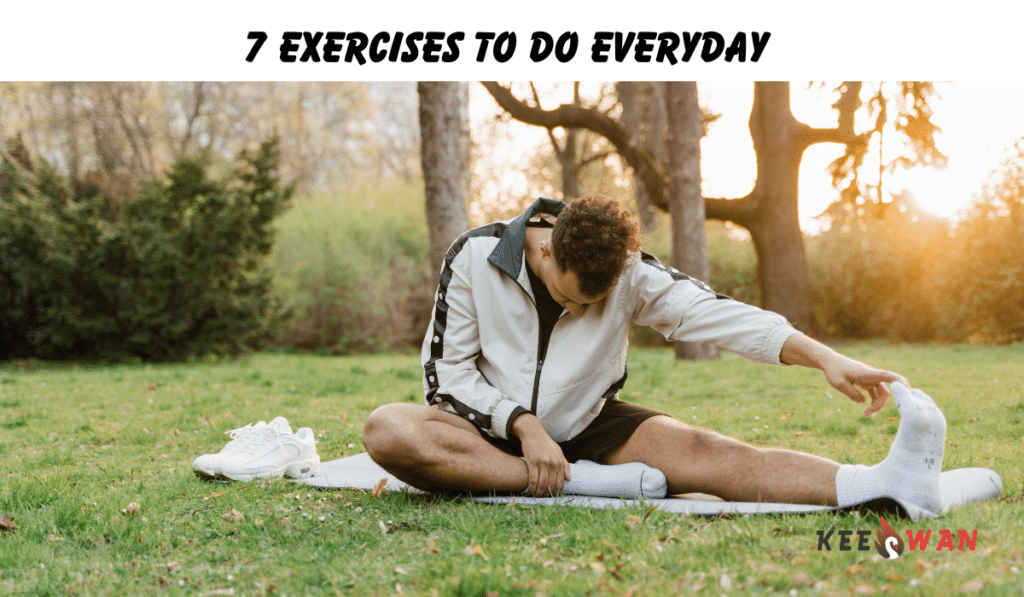Why Exercise is Essential for Good Health
Maintaining good health is a priority for most people, and exercise plays a crucial role in achieving this goal. Regular physical activity has numerous benefits for the body and mind. From improving cardiovascular health to increasing strength and flexibility, exercise is a key component of a healthy lifestyle. In this article, we will explore 7 exercises that you can do every day to improve your overall health and well-being. These exercises are easy to incorporate into your daily routine and can be done with little or no equipment. So, let’s dive in and learn more about these 7 exercises to do every day for good health!
The Importance of Regular Exercise
Exercise is not just about losing weight or building muscles; it is about overall well-being. Regular physical activity has a wide range of benefits that can positively impact your health in various ways. Here are some reasons why exercise is essential for good health:
- Cardiovascular Health: Regular cardiovascular exercise, such as walking, jogging, or cycling, can improve your heart health by increasing your heart rate and strengthening your heart muscles. It also helps in reducing the risk of heart diseases like heart attack and stroke.
- Bone Health: Weight-bearing exercises like walking, running, or weight lifting can help in improving bone density, which is crucial in preventing osteoporosis and maintaining strong bones as you age.
- Mental Health: Exercise has been proven to be beneficial for mental health, as it helps in reducing stress, anxiety, and depression. It also boosts mood by releasing endorphins, the feel-good hormones, which can help in improving overall well-being.
- Weight Management: Regular exercise helps in burning calories and maintaining a healthy weight, which is crucial in preventing obesity and related health issues like diabetes, high blood pressure, and joint problems.
- Muscle Strength and Flexibility: Strength training exercises, such as lifting weights or doing bodyweight exercises, can help in building muscle strength and improving flexibility, which is essential for maintaining mobility and preventing injuries.
- Improved Sleep: Regular exercise has been linked to better sleep quality, which is vital for overall health and well-being. It can help in improving the duration and quality of your sleep, leading to better cognitive function and mood during the day.
- Longevity: Studies have shown that regular exercise can increase life expectancy by reducing the risk of chronic diseases and promoting overall health and well-being.
With these numerous benefits, it’s clear that exercise is essential for maintaining good health. Let’s now explore the 7 exercises that you can do every day to improve your fitness level and overall well-being.
7 Exercises to Do Everyday for Good Health
Incorporating exercise into your daily routine doesn’t have to be complicated or time-consuming. These 7 exercises can be easily done every day to help you maintain good health without requiring a lot of equipment or special skills. Let’s dive into the details of each exercise:
Walking
Walking is one of the simplest and most effective exercises for improving cardiovascular health and maintaining overall well-being. It is a low-impact exercise that can be done by people of all ages and fitness levels. You can easily incorporate walking into your daily routine by taking brisk walks during your lunch break, walking to nearby places instead of driving, or simply going for a stroll in your neighborhood. Here are some tips for effective walking:
- Start with a warm-up: Before you begin your walk, spend a few minutes warming up your muscles with some light stretching or a gentle warm-up walk. This can help prevent injuries and prepare your body for exercise.
- Choose the right footwear: Invest in a good pair of walking shoes that provide proper support and cushioning for your feet. Wearing comfortable shoes can help prevent discomfort and pain during your walks.
- Maintain proper posture: Stand tall, keep your shoulders relaxed, and swing your arms naturally as you walk. Avoid slouching or looking down at your phone, as this can strain your neck and back.
- Increase intensity gradually: As you get more comfortable with walking, you can gradually increase your pace or distance to challenge your cardiovascular system and improve your fitness level. Remember to listen to your body and avoid overexertion.
- Make it enjoyable: Walking can be a great opportunity to enjoy nature, listen to music or podcasts, or socialize with a walking buddy. Find ways to make your walks enjoyable and something you look forward to every day.
Bodyweight Exercises
Bodyweight exercises are exercises that use your own body weight as resistance, making them convenient and accessible for anyone, anywhere. These exercises can help improve your strength, flexibility, and endurance. Here are some popular bodyweight exercises that you can do every day:
- Push-ups: Targeting your chest, shoulders, triceps, and core, push-ups are a great upper body exercise. Start with modified push-ups (on your knees) if you’re a beginner and gradually progress to full push-ups.
- Squats: Squats are a compound exercise that targets multiple muscle groups, including your quadriceps, hamstrings, glutes, and core. Keep your feet shoulder-width apart, lower your body by bending your knees, and then return to a standing position.
- Plank: Plank is a core-strengthening exercise that also engages your arms, shoulders, and back. Start in a push-up position and lower down onto your forearms. Keep your body in a straight line from head to toe, engaging your core muscles.
- Lunges: Lunges are great for strengthening your lower body, including your quadriceps, hamstrings, and glutes. Take a step forward with one leg, lower your body by bending your knees, and then return to the starting position. Alternate between legs.
- Glute Bridge: Glute bridge is a great exercise for targeting your glutes, hamstrings, and lower back. Lie on your back with your feet flat on the ground, hip-width apart. Lift your hips up towards the ceiling while squeezing your glutes, and then lower back down.
Cardiovascular Exercise
Cardiovascular exercise, also known as aerobic exercise, is important for improving heart health, burning calories, and increasing endurance. There are many options for cardiovascular exercise, and you can choose the ones that you enjoy the most. Here are some examples:
- Running: Running is a high-impact cardiovascular exercise that can help improve your cardiovascular fitness and burn calories. You can run outdoors or on a treadmill, depending on your preference and availability.
- Cycling: Cycling is a low-impact exercise that is easy on the joints and can be done indoors on a stationary bike or outdoors on a bicycle. It is a great way to improve your cardiovascular fitness, leg strength, and endurance.
- Jumping Rope: Jumping rope is a fun and effective cardiovascular exercise that can be done anywhere with just a simple rope. It helps improve your coordination, agility, and cardiovascular fitness.
- Dancing: Dancing is not only a fun and enjoyable way to exercise, but it is also a great cardiovascular workout. You can take dance classes or simply dance around in your living room to your favorite music.
- Swimming: Swimming is a low-impact exercise that is gentle on the joints and provides a full-body workout. It is a great option for those who may have joint pain or injuries, and it helps improve cardiovascular fitness, muscle strength, and flexibility.
Yoga and Stretching
Yoga and stretching exercises are important for maintaining flexibility, improving posture, and reducing the risk of injuries. They also help in relaxation and stress reduction. Here are some yoga and stretching exercises you can incorporate into your daily routine:
- Cat-Cow Stretch: Begin on your hands and knees, and alternate between rounding your back like a cat and arching it like a cow. This helps to stretch and strengthen the spine.
- Forward Fold: Stand with your feet hip-width apart, and fold forward from the hips, reaching towards the ground. This helps to stretch the hamstrings, calves, and lower back.
- Downward Dog: Start in a plank position, then lift your hips up towards the ceiling, creating an inverted V shape with your body. This helps to stretch the hamstrings, calves, shoulders, and back.
- Child’s Pose: Sit back on your heels with your arms extended in front of you, and rest your forehead on the ground. This is a relaxing pose that helps to stretch the lower back, hips, and shoulders.
- Tree Pose: Stand with your feet together, and place one foot on the inner thigh of the opposite leg. Balance and extend your arms overhead. This helps to improve balance, posture, and concentration.
Resistance Training
Resistance training, also known as strength training or weight lifting, is crucial for building muscle mass, increasing bone density, and boosting metabolism. It is important to include resistance training in your everyday exercise routine. Here are some tips for effective resistance training:
- Start with lighter weights: If you’re a beginner, start with lighter weights and focus on proper form and technique. Gradually increase the weight as you get stronger and more comfortable with the exercises.
- Use compound exercises: Compound exercises involve multiple muscle groups, making them more efficient and effective. Examples of compound exercises include squats, deadlifts, and bench presses.
- Include all major muscle groups: Make sure to include exercises that target all major muscle groups, including the chest, back, legs, arms, and core. This ensures balanced muscle development and prevents muscle imbalances.
- Rest and recover: Allow your muscles to rest and recover between resistance training sessions to avoid overtraining and injury. Aim for at least 48 hours of rest between sessions for the same muscle group.
- Proper form is key: Focus on maintaining proper form throughout your resistance training exercises to prevent injuries and maximize the effectiveness of your workouts. Consider working with a personal trainer or fitness professional to ensure you are using proper form.
Flexibility Exercises
Flexibility exercises are important for maintaining joint mobility, preventing injuries, and improving overall functional fitness. Here are some examples of flexibility exercises that you can do daily:
- Static stretching: Static stretching involves holding a stretch in a stationary position for 15-30 seconds. You can stretch various muscle groups, such as your hamstrings, quadriceps, calves, and shoulders.
- Dynamic stretching: Dynamic stretching involves moving your muscles and joints through their full range of motion. Examples of dynamic stretching include arm circles, leg swings, and torso twists.
- Yoga: As mentioned earlier, yoga is not only beneficial for cardiovascular health, but it also includes various stretching exercises that help improve flexibility, balance, and relaxation.
- Pilates: Pilates is another form of exercise that focuses on strengthening and stretching the muscles, particularly the core muscles. It helps improve flexibility, posture, and body awareness.
Mind-Body Exercises
Taking care of your mental health is just as important as taking care of your physical health. Mind-body exercises can help reduce stress, improve mood, and increase overall well-being. Here are some mind-body exercises to consider incorporating into your daily routine:
- Meditation: Meditation involves focusing your attention and eliminating the stream of thoughts that may be crowding your mind. It can help reduce stress, improve concentration, and promote relaxation.
- Deep breathing: Deep breathing involves taking slow, deep breaths and focusing on your breath as you inhale and exhale. It can help calm the mind, reduce stress, and promote relaxation.
- Tai Chi: Tai Chi is a gentle form of martial art that involves slow, flowing movements and deep breathing. It helps improve balance, flexibility, and relaxation.
- Mindful walking: Mindful walking involves paying attention to your surroundings, your body, and your breath as you walk. It can help improve mindfulness, reduce stress, and promote relaxation.
FAQs
Can I do these exercises every day?
Yes, all of the exercises mentioned in this article can be done every day for good health. However, it is always best to consult with your healthcare provider before starting a new exercise routine, especially if you have any underlying health conditions or concerns.
How long should I do each exercise?
The duration of each exercise may vary depending on your fitness level and goals. It is recommended to follow the guidelines provided by a certified fitness professional or your healthcare provider. Generally, aim for at least 30 minutes of moderate-intensity exercise, such as brisk walking or cycling, on most days of the week, and incorporate resistance training, flexibility exercises, and mind-body exercises as part of your routine.
Can I modify the exercises if I have physical limitations?
Yes, it is important to listen to your body and modify the exercises if you have physical limitations. You can work with a fitness professional or healthcare provider to adapt the exercises to your needs, such as using lighter weights, doing modified versions of certain exercises, or using props for support. It’s important to prioritize safety and avoid pushing yourself beyond your limits.
Are these exercises suitable for all age groups?
Yes, these exercises can be adapted for different age groups and fitness levels. However, it’s important to consider any specific health concerns or limitations that may affect certain age groups, such as osteoporosis in older adults or growth plate injuries in children. Consult with your healthcare provider or a fitness professional for appropriate exercises for your age group.
Conclusion:
Incorporating regular exercise into your daily routine is essential for maintaining good health. The “7 exercises to do everyday for good health” that we have discussed in this article include cardiovascular exercises, strength training, flexibility exercises, and mind-body exercises. These exercises provide a well-rounded fitness routine that can help improve cardiovascular fitness, increase muscle strength, flexibility, balance, and promote mental well-being. Remember to always consult with your healthcare provider or a certified fitness professional before starting a new exercise routine, especially if you have any underlying health conditions or concerns. So, lace up your shoes, grab your dumbbells, and get moving towards a healthier, happier you!
Learn more fitness related articles at keeswan.com.




